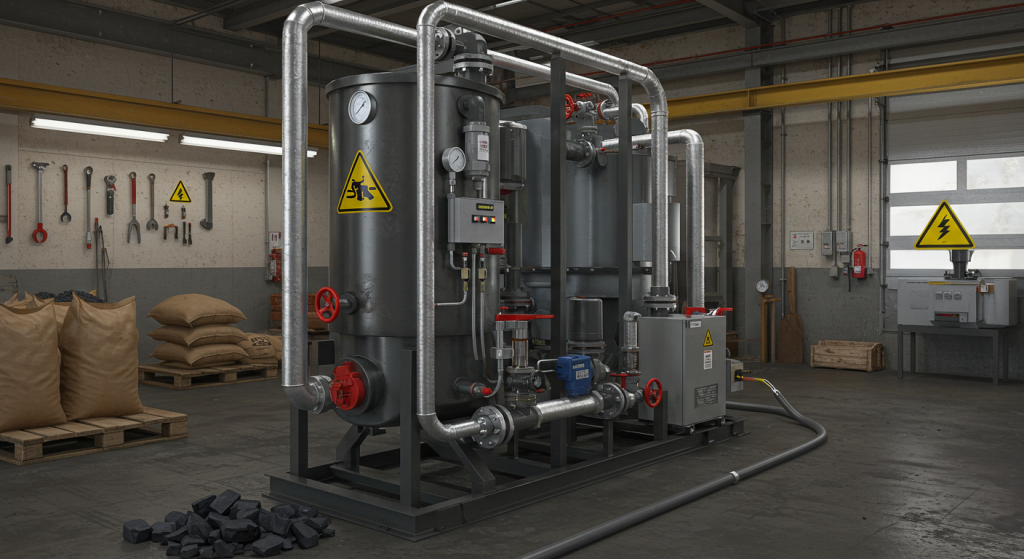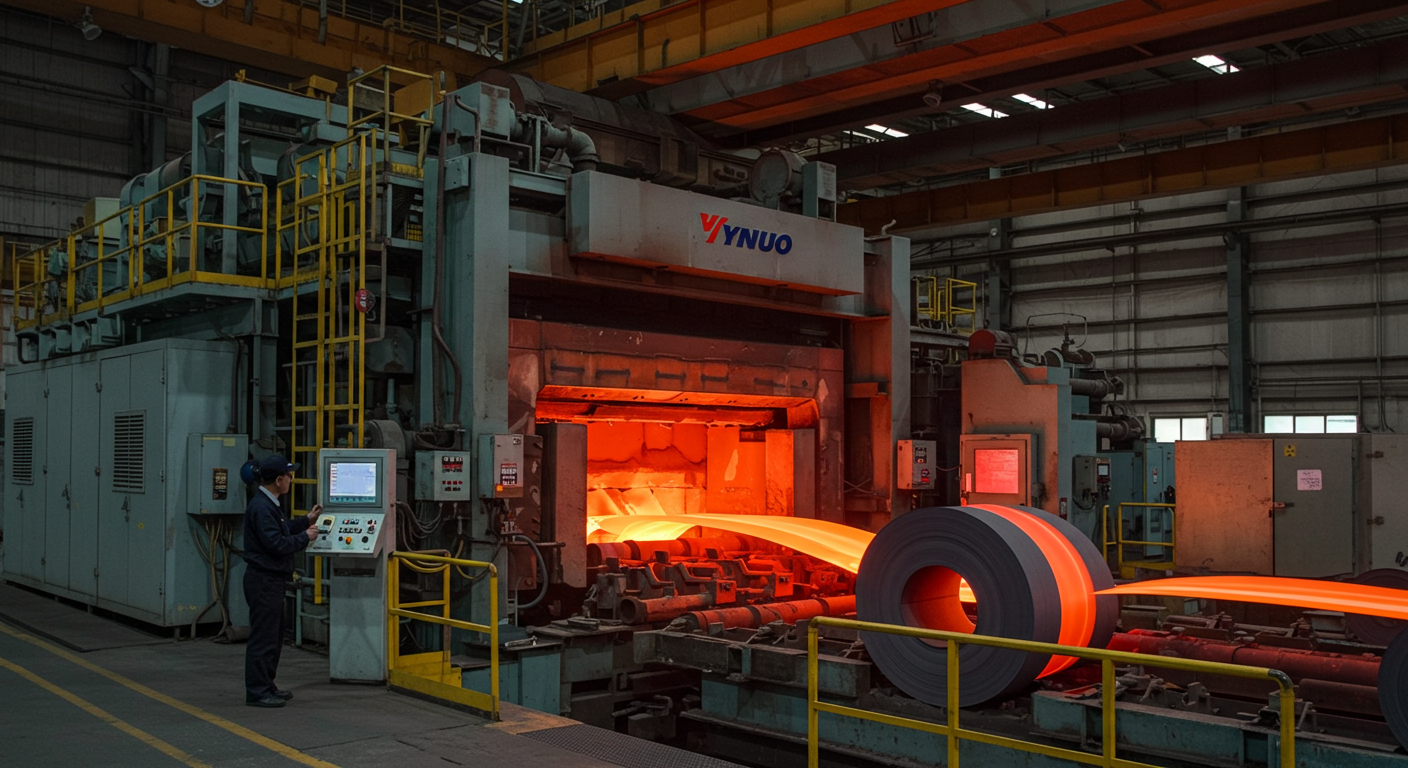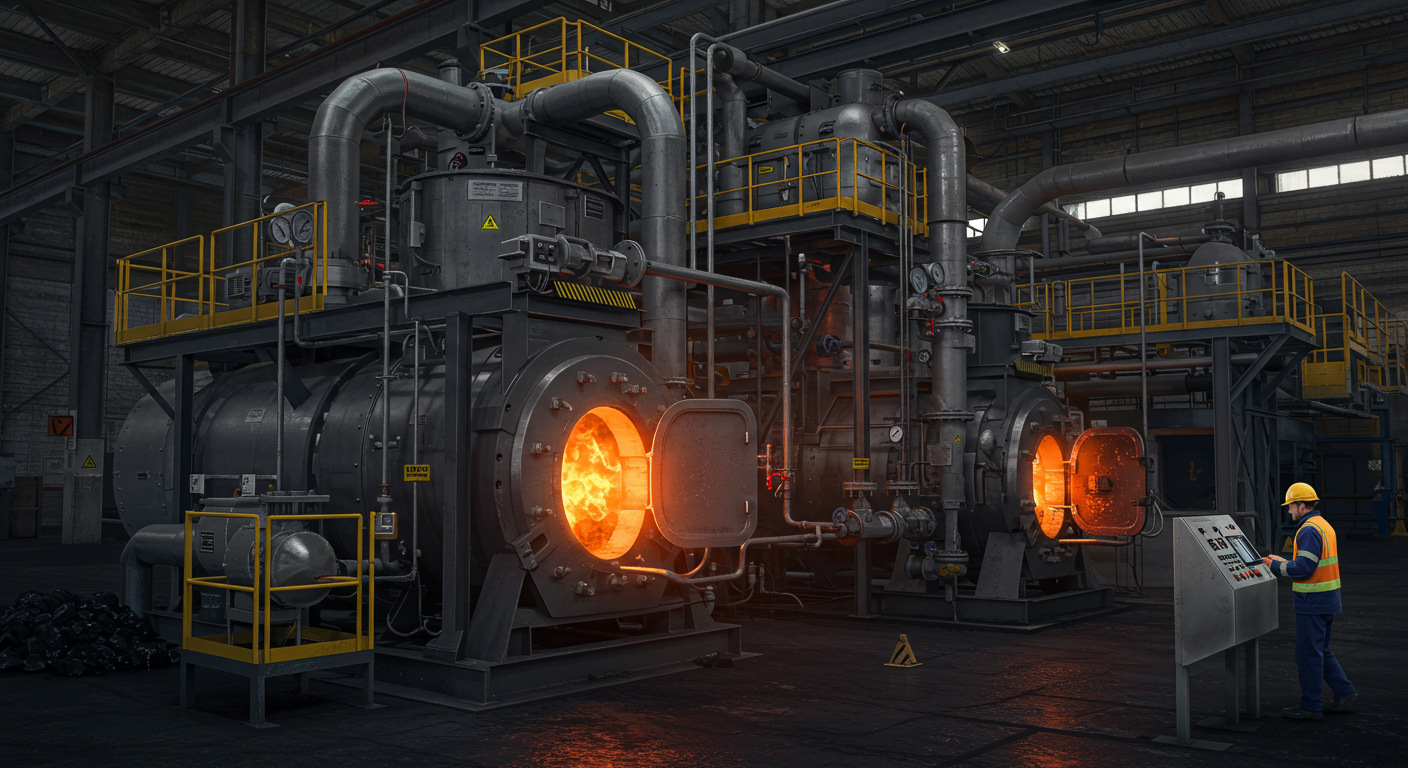
Small coal gasifiers are compact systems designed to convert coal into syngas (synthesis gas), a mixture primarily of carbon monoxide (CO) and hydrogen (H₂), for use in heating, power generation, or chemical production. These systems are gaining attention for their potential to utilize coal in a more efficient and cleaner manner, particularly in small-scale industrial applications or remote areas. Jiangsu Yinuo Thermal Energy Technology Co., Ltd., based in Xuzhou, China, is recognized for its expertise in advanced thermal energy solutions, which can include gasification technologies. This article explores the technology, applications, benefits, and challenges of small coal gasifiers, providing a detailed overview to inform industrial stakeholders. A comparison table is included to highlight key differences between small coal gasifiers and other gasification systems.
Overview of Small Coal Gasifiers
Small coal gasifiers operate by thermochemically converting coal into syngas under controlled conditions, typically at temperatures between 600°C and 1200°C, using air, steam, or oxygen as gasifying agents. Unlike large-scale gasifiers, these systems are modular, often with capacities below 700 kWth (thermal power), making them suitable for localized or niche applications. The syngas produced can power internal combustion engines, small scale burners, or serve as a chemical feedstock, offering a versatile alternative to direct coal combustion.
Technology and Operation
The gasification process involves partial oxidation of coal in a low-oxygen environment, breaking it down into its primary chemical constituents. The resulting syngas, composed mainly of CO, H₂, and sometimes methane (CH4), is cleaned to remove impurities like tar, sulfur compounds, and particulate matter before use. Small coal gasifiers typically employ fixed-bed, up-draft, or down-draft designs due to their simplicity and cost-effectiveness at smaller scales.
Core Components
A small coal gasifier consists of a gasification chamber constructed from refractory materials to withstand high temperatures. The reactor, where coal reacts with gasifying agents, is often made of stainless steel or ceramic-lined plates for durability. Air or steam injection systems regulate the gasification environment, while a burner or gas cleanup system removes tar and particulates. Control systems, such as basic PLCs, manage temperature, feedstock flow, and gas output. Conveyance systems, like screw feeders or augers, ensure continuous coal input, and exhaust systems handle ash and byproduct removal.
Operational Mechanism
Coal is fed into the gasifier’s reactor, where it undergoes pyrolysis, releasing volatile compounds. The remaining char reacts with steam or air in an oxygen-limited environment, producing syngas. In up-draft gasifiers, gas flows upward, absorbing heat and tars, requiring extensive cleanup. Down-draft gasifiers direct gas through a hot char zone, reducing tar content, making them suitable for engine applications. The syngas is cooled, filtered, and directed to engines, burners, or storage. The process operates at near-atmospheric pressure, simplifying design and reducing costs.
Applications of Small Coal Gasifiers
Small coal gasifiers find applications in industries and settings where localized energy solutions or chemical feedstocks are needed. Their compact size and flexibility make them ideal for specific industrial and remote use cases.
Small-Scale Power Generation
Small coal gasifiers coupled with reciprocating engine generators provide electricity in remote or off-grid areas. The syngas powers internal combustion engines, producing 10–700 kW of electricity. This is particularly relevant in regions with abundant coal reserves but limited grid access, such as rural areas in Indonesia or Alaska, where modular systems support combined heat and power (CHP) applications.
Industrial Heating
In small-scale industries, such as food processing or manufacturing, gasifiers supply syngas for heating applications. For example, a top-lit updraft (TLUD) gasifier stove developed in Jakarta uses raw coal to fuel frying operations, demonstrating cost-effective thermal energy for small businesses. These systems replace expensive fuels like LPG, reducing operational costs.
Chemical Feedstock Production
Syngas from small coal gasifiers serves as a feedstock for producing chemicals like methanol or ammonia. In regions with high coal availability, such as China or India, these systems support localized chemical production, reducing reliance on imported fuels. The hydrogen-rich syngas is particularly valuable for ammonia synthesis in agriculture.
Waste Utilization and Co-Firing
Small coal gasifiers can process low-grade coals or co-fire with biomass, reducing waste and enhancing sustainability. Projects like the Alaska Syngas initiative demonstrate the potential to blend coal with up to 20% biomass, producing syngas and pyrolysis liquids for power and heating, addressing both energy and waste management needs.
Benefits of Small Coal Gasifiers
Small coal gasifiers offer distinct advantages, making them a compelling choice for localized energy and industrial applications, particularly in coal-rich regions.
Energy Efficiency
Fixed-bed up-draft gasifiers achieve thermal efficiencies of 70–80%, converting a significant portion of coal’s energy into syngas. The ability to use low-grade coals or coal wastes enhances resource utilization, reducing fuel costs compared to traditional combustion systems.
Cost-Effectiveness
Modular, low-pressure designs, like those developed by Klean Industries, require lower capital investment than large-scale gasifiers, which often operate at 500–1000 PSI. Operating costs are reduced due to minimal syngas compression needs and the use of abundant, inexpensive coal, offering savings for small industries.
Environmental Advantages
Compared to direct coal combustion, gasification produces cleaner syngas with lower sulfur dioxide (SO2) and particulate emissions. Integrated gas cleanup systems remove tar and pollutants, aligning with environmental regulations. The potential for carbon capture in high-pressure systems further reduces CO2 emissions, though less common in small-scale setups.
Flexibility and Scalability
Small coal gasifiers handle diverse feedstocks, including coal, biomass, and waste, offering operational flexibility. Modular designs allow scalability, enabling deployment in remote areas or small plants without the financial risk of large-scale facilities, as noted in DOE’s Gasification Systems Program.
Challenges of Small Coal Gasifiers
Despite their benefits, small coal gasifiers face technical and environmental challenges that impact adoption and performance, requiring careful consideration.
Tar and Pollutant Management
Up-draft gasifiers produce high tar levels (up to 52 g/Nm³), complicating syngas cleanup for engine use. Down-draft designs reduce tar but may not eliminate it entirely. Advanced tar removal systems, like those in the Alaska Syngas project, increase costs but are necessary for clean operation.
Environmental Concerns
While cleaner than combustion, gasification still emits CO2 and other pollutants. Small-scale systems often lack integrated carbon capture, limiting their environmental benefits. Ash and sulfur byproducts require proper disposal to avoid contamination, posing challenges in remote areas.
Operational Complexity
Maintaining consistent syngas quality requires skilled operation and regular maintenance, particularly for gas cleanup systems. Small industries may lack the expertise or resources, increasing downtime and costs. Automation can mitigate this but adds to initial investment.
Market Competition
Renewable energy sources, such as solar and wind, compete with coal gasification due to lower environmental impact and declining costs. High construction costs for gasification plants, noted as 35% more expensive than conventional coal technology, hinder market growth in some regions.
Comparison Table: Small Coal Gasifiers vs. Other Gasification Systems
| Feature | Small Coal Gasifier | Large-Scale Coal Gasifier | Biomass Gasifier | Conventional Coal Combustion |
|---|---|---|---|---|
| Scale | <700 kWth, modular, small-scale. | >1 MWth, large industrial plants. | Small to medium, 10–1000 kWth. | Large-scale, power plants. |
| Feedstock | Low-grade coal, coal waste, biomass blends. | High-grade coal, blends. | Biomass, waste materials. | Coal, often high-grade. |
| Efficiency | 70–80% thermal efficiency (fixed-bed). | 80–90% (entrained-flow/IGCC). | 60–75% (fixed-bed/fluidized). | 30–40% (boiler systems). |
| Emissions | Lower SO2, particulates; high tar in up-draft. | Low with CCS; high CO2 without. | Low CO2, some tar issues. | High SO2, CO2, particulates. |
| Capital Cost | Low to moderate ($0.5–2M for small units). | High ($100M+ for IGCC plants). | Moderate ($0.3–1.5M). | High for large plants ($50M+). |
| Applications | Power, heating, chemicals for small industries. | Large-scale power, chemicals. | Rural power, heating, waste management. | Utility-scale power generation. |
| Tar Production | High in up-draft (up to 52 g/Nm³), low in down-draft. | Low (entrained-flow). | Moderate to high (fixed-bed). | None (direct combustion). |
| Maintenance | Moderate, requires tar cleanup expertise. | High, complex systems. | Moderate, biomass variability issues. | High, ash and emissions control. |
| Environmental Impact | Moderate, reduced emissions vs. combustion. | Low with CCS, high without. | Low, renewable feedstocks. | High, significant emissions. |
| Scalability | Highly scalable, modular designs. | Limited, large-scale only. | Scalable, but feedstock-dependent. | Limited, large-scale focus. |
Technical Insights into Small Coal Gasifiers
Small coal gasifiers leverage specific technologies to optimize performance at reduced scales, addressing the needs of localized energy solutions.
Gasifier Types
Fixed-bed up-draft gasifiers, as used in the Alaska Syngas project, offer high conversion efficiency but produce significant tar, requiring advanced cleanup systems. Down-draft gasifiers reduce tar by directing gas through a hot char zone, suitable for engine applications. Fluidized-bed gasifiers, though less common in small scales, provide efficient mixing and handle low-quality coals, as noted in market reports.
Syngas Cleanup
Tar and particulate removal is critical for engine or burner applications. Wet scrubbing, electrostatic precipitators, or advanced filtration systems, like those in the Alaska project, clean syngas but increase complexity. Low-pressure operation, as in Klean’s systems, simplifies cleanup but limits syngas compression for large-scale use.
Automation and Control
Basic PLC-based controls monitor temperature, air/steam flow, and syngas composition, ensuring stable operation. IoT integration, though rare in small systems, enables remote monitoring and predictive maintenance, reducing downtime in remote installations.
Industry-Specific Considerations
Different applications require tailored rolling steel heating furnace configurations to meet specific process and material demands. Understanding these requirements ensures optimal performance and cost efficiency.
Remote Power Generation
In regions like Alaska or rural Indonesia, small coal gasifiers provide off-grid power using local coal. Modular designs and low-pressure operation reduce infrastructure needs, but tar management and maintenance remain challenges. Biomass co-firing enhances sustainability, as seen in DOE-funded projects.
Small-Scale Industry
Industries like food processing or small manufacturing benefit from gasifiers for cost-effective heating. The Jakarta TLUD gasifier stove demonstrates savings over LPG, but requires operator training to manage coal feeding and ash disposal, limiting scalability.
Chemical Production
Localized ammonia or methanol production uses syngas from small gasifiers, leveraging coal’s availability in countries like India. High hydrogen content (up to 80% in some systems) supports chemical synthesis, but high tar levels in up-draft gasifiers necessitate robust cleanup systems.
Future Trends in Small Coal Gasifiers
The small coal gasifier industry is evolving, driven by advancements in efficiency, sustainability, and integration with other technologies, shaping their role in industrial applications.
Modular and Scalable Designs
Modular gasifiers, as emphasized by DOE and Klean Industries, reduce capital costs and enable deployment in remote areas. Scalability supports incremental expansion, aligning with localized energy needs and reducing financial risk compared to large-scale plants.
Integration with Carbon Capture
While less common in small systems, integrating carbon capture and storage (CCS) could enhance environmental performance. Pre-combustion CO2 capture in gasification systems achieves over 90% efficiency, offering potential for decarbonizing coal use, though cost remains a barrier.
Biomass and Waste Co-Firing
Co-firing coal with biomass or municipal solid waste, as in the Alaska Syngas project, reduces emissions and utilizes waste. This trend supports circular economy principles, particularly in regions with abundant biomass resources, enhancing market appeal.
Automation and Smart Technology
IoT-enabled controls and AI-driven optimization, though currently limited in small gasifiers, could improve efficiency and reduce maintenance needs. Remote monitoring systems would benefit off-grid installations, aligning with global trends in smart manufacturing.
Choosing the Right Small Coal Gasifier
Selecting a small coal gasifier requires evaluating application, feedstock, and operational needs to ensure performance and cost efficiency.
Key Considerations
Feedstock type, such as low-grade coal or biomass blends, determines gasifier design, with fixed-bed systems offering flexibility. Application—power, heating, or chemicals—dictates syngas quality and cleanup requirements. Production scale influences system size, with modular units suiting small industries. Energy efficiency, driven by gasifier type and burner design, impacts costs. Maintenance and operator expertise are critical for reliable operation in remote settings.
Partnering with Jiangsu Yinuo
Jiangsu Yinuo’s team provides expert guidance, designing custom gasification solutions tailored to industrial goals. Installation and ongoing support ensure seamless performance, delivering precision and efficiency. Clients can explore solutions and connect through the Jiangsu Yinuo website for tailored options, backed by global expertise.
FAQ
What is the purpose of a small coal gasifier?
Small coal gasifiers convert coal into syngas for power generation, heating, or chemical production in localized applications.
What feedstocks can small coal gasifiers process?
Low-grade coal, coal waste, and biomass blends are processed, supporting diverse industrial and remote applications.
How is gasifier quality ensured?
Production involves rigorous testing of components, using premium materials, with compliance documentation meeting ISO and CE standards.
Are small coal gasifiers customizable?
Gasifiers are tailored to specific feedstock, process, and production needs, with support from design to installation.
How energy-efficient are small coal gasifiers?
Fixed-bed gasifiers achieve 70–80% thermal efficiency, reducing fuel use and costs compared to combustion.
How can a quote be requested from Jiangsu Yinuo?
A contact form, email, or phone inquiry through the Jiangsu Yinuo website provides a prompt response.
Conclusion: Advancing Localized Energy with Small Coal Gasifiers
Small coal gasifiers offer efficient, flexible solutions for power, heating, and chemical production, particularly in coal-rich or remote regions. Jiangsu Yinuo Thermal Energy Technology Co., Ltd. provides innovative, customized systems that empower industrial manufacturers globally. With advanced technology and a focus on performance, these gasifiers meet the demands of modern energy needs. Explore solutions and connect through the website for a tailored quote to enhance production capabilities today.







